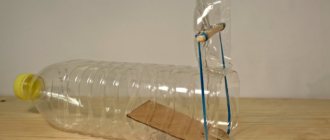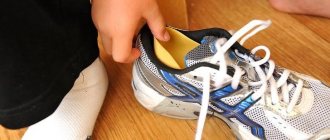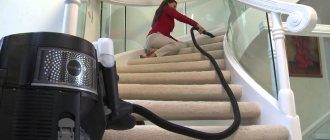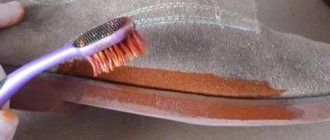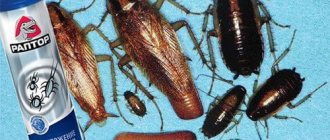Home House and cottage Do it yourself
A do-it-yourself mousetrap made from scrap materials can cope with the task of catching no worse than an industrial product of a similar purpose. In addition, some types of homemade mouse traps do not kill the animal, but only limit its freedom of movement. This moment attracts those who, for whatever reason, do not want to cause the death of an animal and are ready to take on the burden of taking it away from home in order to release it.
Despite their cute appearance, mice can bring a lot of trouble into your home. The smallest is the noise at night created by rodents moving in the cavities of the building. Often, following the smell of food, mice encounter obstacles to their movement in the form of various building structures. If such parts are made of materials that are accessible to the incisors of mice, the animals will damage them.
Mice cause damage not only by eating food. Naturally, a mouse that gets to them is not able to eat everything, but you are unlikely to want to use food that mice have walked through. One of the negative aspects of being around mice is their smell. It is not only unpleasant, but also very persistent.
Mice can cause a fire - these rodents are not averse to tasting the insulation of laid electrical wires, which will cause a short circuit that provokes a fire. In addition, mice are very fond of such a habitat as polystyrene foam, which is easy to gnaw through passages. They often settle in places where polystyrene foam was used as insulation.
Mice are animals that excrete excrement directly as it accumulates in the corresponding organs. Therefore, if mice have entered food storage areas, they will not only gnaw through the packaging, but will also leave behind traces of their visit in the form of excrement, which, naturally, will render the food supplies unusable.
The main danger lurking in mice
Mice are not just unpleasant neighbors, but also quite dangerous animals for human health. These rodents are natural carriers of microbes that cause diseases such as:
- various lichens and fungal diseases;
- salmonellosis;
- toxoplasmosis;
- leptospirosis;
- rabies;
- tularemia;
- pseudotuberculosis;
- rickettsiosis.
In addition, a mouse can become a source of infection with the rabies virus. The mouse itself does not bite a person, but it can manage to bite a cat that is hunting for it and infect it. Subsequently, the already sick cat attacks people.
The negative aspects of the neighborhood of mice are not limited to those listed, but the examples given are enough to take all measures to remove these rodents.
Effective mousetraps are often relevant not only for private houses in rural areas, but also for residents of apartment buildings in the city. With the onset of cold weather, rodents move to where it is warmer, and channels for laid communications and ventilation shafts make it possible to reach the upper floors. If food leftovers are not removed from the apartment at night, the trash can is left open, and there is general unsanitary conditions, there is a high probability of mice appearing.
Traditional methods
Folk methods involve a wide range of devices and methods for destroying or removing mouse brood. While we have already looked at homemade traps, we have not yet studied means that can drive away harmful neighbors.
A mint solution is effective in controlling rodents Source stroy-podskazka.ru
Coriander (cilantro) against mice Source autogear.ru
Yellow tansy flowers Source parazitdoma.ru
Peppermint
Peppermint is often used to control mice. This is an accessible, cheap and effective remedy. The aroma of the plant is pleasant to human charm, but intolerable to rodents. The herb can be used in one of 3 ways:
- Place grass in the corners of the room, plant a plant in the local area.
- Brew a strong decoction and spray the areas where mice were spotted.
- Soak rolled cotton balls or disks in the broth and place them in the corners of the room.
Mousetrap or cat
Cats are often cited as the best remedy for mice. However, this is not true. Firstly, as practice shows, the smell of a cat is not a factor for mice that forces them to immediately leave the place where such a mark is present. Secondly, the cat hunts mice only when it is hungry, and, having eaten, stops hunting. There is no strict scientific data on how many mice a cat catches. The only statistically reliable can be considered the recorded count of mice caught by the Scottish cat Towser over the course of twenty-one years. Their number was 28,899 rodents, but if we consider the day, then this is only 4 mice during the cat’s waking period.
The famous Austrian ethologist Konrad Lorenz cites an interesting case in his books. The mousetrap, made from a handy object such as a bucket, caught about two dozen mice overnight. A cat was thrown among the rodents. The pet quickly strangled 4 mice, grabbed one of the victims in its teeth and jumped out of the bucket. Having eaten the prey, the cat did not return to the trap, but calmly went home.
Unlike a live mouse trap, properly made traps are more effective and permanently control rodents.
Inhumane approach to rodent extermination
Poisons and chemicals intended to poison mice have a number of disadvantages:
- addiction of individuals to poison;
- refusal of bait;
- poisoning of pets.
And the most significant drawback is the death of the rodent from poisoning in a place inaccessible to humans, followed by the unpleasant smell of decomposition for a fairly long period of time.
Read a question from a reader - What should you do if a rat eats poison and dies somewhere in the house and it stinks?
A humane solution to the rodent problem
Gentle ways to get rid of creatures are ultrasonic repellers and a contactless trap-container, which, if caught, remains alive and well.
More bloodthirsty methods are glue fishing, chemical poisoning and mechanical traps.
A modern invention - an electronic mousetrap - is the most humane, so to speak, method of exterminating pests, since it leads to the instant destruction of an individual without suffering. You can also make a humane mousetrap with your own hands from available materials!
Operating principle of an electronic mousetrap
A modern electronic mousetrap is a specialized trap for small rodents that releases a strong electric current when the animal gets inside. Unlike ultrasonic repellers, traps destroy mice, which helps to completely clean the room of toothy pests.
The operating principle of an electronic mousetrap is extremely simple: a rodent, lured by the aroma of a treat, climbs inside the trap and receives an instantly fatal discharge of electric current with a power of 8000 V.
In addition, the design of the mousetrap is designed in such a way that the mouse is attracted to the rounded shape of the entrance to the trap, this reminds the animal of gnawed passages. And together with the fragrant bait, these factors do not give the rodent a chance to pass by.
What types of mousetraps are there?
For better visibility, here is a brief description of the main types of mousetraps used to control rodents:
- Mousetrap on a spring. The simplest and cheapest option. The spring is tensioned and the bait is placed nearby. The mouse, pulling the bait, activates the spring, and it slams the animal;
- Traps. The principle of operation is the same as that of a spring mousetrap, there is a slight difference in design;
- Cage mousetraps. A gentle method in which the animal remains unharmed and can be released;
- Glue. This is precisely one of the most cruel methods of extermination. The animal, stuck to the trap, dies a long and painful death from hunger and dehydration;
- Homemade devices. Our people are rich in wisdom and worldly tricks. Many craftsmen are able to invent something of their own to combat rodents, but the principles of operation of such devices are the same as those purchased;
- Electronic mousetraps. Modern traps, which are discussed in this article.
How to make an electric mousetrap with your own hands
The skills of handicraftsmen reach the point that many craftsmen make at home not only elementary spring traps, but also complicated electronic mousetraps with their own hands.
Moreover, there is a fairly common option - a harmless cage trap, which, when an animal gets into it, slams shut and notifies with a signal that there is an animal in the cage. Such traps are used not only for pest control, but also for catching small domestic animals without the purpose of extermination (for example, a hamster that has escaped from its cage). A diagram of such a device can easily be found in various sources, including on the Internet.
We also recommend that you familiarize yourself with the Security and Protective Deratization System (OPDS) - operating principle, installation, maintenance and efficiency of the system
Types and Types of Mouse Traps
Broadly speaking, mouse traps can be classified according to their capture methods.
- Mechanical traps.
- Sticky traps.
- Electronic traps.
Various poisoned baits are also used to kill small rodents. The use of such baits has some limitations:
- it is undesirable to use if there is a possibility of poisoned baits being eaten not only by mice, but also by domestic animals;
- allergic reactions may occur in people;
- if the corpse of a poisoned mouse is eaten by a pet (dog, cat), it may be poisoned;
- If a poisoned mouse dies within the house in a hard-to-reach place, for example, under the floor, the smell of decomposition will bring many unpleasant moments.
Unlike poisoned baits, traps do not have the listed negative features.
A piece of paper can help make sure that there are mice in the house. It needs to be crumpled up and placed overnight in front of the hole that could serve as the entrance to the burrow. If in the morning it turns out that the piece of paper has been discarded, it means that uninvited guests have indeed appeared in the house.
Mouse baits
It is believed that a mouse will never refuse a piece of cheese, but this statement is fundamentally wrong: the cheese will be eaten if there are no more delicious delicacies in the house.
Read more ► How to get rid of mice: effective control methods, the best remedy
What is best to place in a trap so that the tailed animal is sure to climb into it:
- Smoked lard takes first place in the ranking of mouse delicacies. Not a single rodent can resist its smell.
- Aromatic vegetable oil is second on the list. Mice love both sunflower and olive oils.
- Wheat bread is in third place. To enhance the attractiveness of the bait, you can moisten a piece of white bread with aromatic oil.
- Roasted seeds - all types are extremely attractive to animals. For bait you only need to take a few pieces. Pumpkin seeds are preferable.
- Nuts - hazelnuts, peanuts or almonds will be an excellent bait.
- Raw smoked sausage is similar in aroma to smoked lard and can successfully replace it as bait.
- A piece of smoked fish is another tasty dish for tailed invaders.
- Fragrant baked goods with the smell of vanilla - the product will attract animals with its sweet smell.
Advantages of self-made traps
Trade organizations offer many different devices designed for catching small rodents. But self-made traps are still somewhat preferable for a number of reasons:
- Since self-made traps are made from existing materials at hand, they will not require purchasing costs;
- Unlike some types of poisoned baits that cause allergies or have an unpleasant odor, using homemade traps will not require you to leave the house;
- Self-made traps do not pose a danger to small children;
- Possible repeated use without unnecessary costs;
- If it breaks, it's easy to make a new one.
Traps made from cans and buckets
The easiest and most effective traps to make can be made from scrap materials available in almost every household, such as buckets and various jars.
Using glass jars from eaten homemade preparations for the winter, you can make a simple trap. A ½ liter jar is enough. Using chewing gum or other adhesive material, such as a piece of insulating tape, a string with bait attached to it is attached to the bottom of the jar. The length of the string is chosen so that the bait hangs freely in the jar turned upside down, and the rodent needs to pull the string to make it more convenient to eat the treat. The jar is turned over and placed so that it rests with the edge of the upper cut of the vessel on some object that is in a state of unstable equilibrium, for example, on a large diameter coin placed on its edge. The diameter of the coin should be such that the resulting gap gives the rodent the opportunity to freely penetrate under the jar. A mouse that sneaks into the jar takes the bait, begins to pull it towards itself, the balance is disturbed and the coin, and after it the jar falls - the mouse finds itself under the jar and cannot get out on its own.
The disadvantages of such a trap include its disposability, that is, until the mouse is removed from the jar, which will have to be installed again above the bait, no other mice will be caught. The simplest traps made from a bucket and available materials do not have this drawback.
To make the simplest version of such a trap, you only need a bucket and a sheet of paper, the area of which allows you to cover the bucket. Even a newspaper will do. The bucket is covered with paper, in which slits are made radially from the center. Bait is placed in the center, for example, grain is poured. You can also hang the bait over the center, from which the slots radiate radially. They also create an opportunity for mice to climb to the top edge of the bucket by installing a flat bar at an angle (this part of homemade traps is called a “zadnik”). Attracted by the smell of the bait, the mouse climbs the rail and rushes towards the food - under the influence of the weight of the rodent, the paper bends in the slots and the mouse falls into the bucket.
Using a bucket you can make another type of trap. In addition to the bucket you will need:
- ruler or thin wooden strip;
- a piece of wire;
- spoke.
The knitting needle is attached across the ruler and, acting as a support, is placed on the top edge of the bucket. The length of the rack or ruler should be such that one end rests on the edge of the bucket, and the other end hangs above the bottom. The bait is placed at this end. The trap is installed so that the rodent can easily reach the ruler. The second end of the ruler is attached to the edge of the bucket with a thread of such length that the ruler can rotate at an angle of 70 to 85 degrees. Under the weight of the mouse moving towards the bait, the ruler will rotate and the rodent will slide into the bucket. The thread will hold the second end of the ruler, and under the influence of its weight it will return to its original position. If the bait is firmly attached to the ruler, the trap will be ready for use again.
It is easy to make a mouse trap from scrap materials, the principle of which is based on the inability of the mouse to stay on a rotating surface. Metal cans, drink packaging, and plastic bottles can be used as a part to ensure effective operation of the trap. How to make such a trap can be seen in the photo.
The bait is attached to the outside of the jar or bottle, which will rotate under the influence of the rodent's weight and the mouse trying to get to the food will slide into the bucket. If you attach baits in several places opposite each other, so that after turning the bottle one of the baits remains on the upper side, then several mice can get caught in such a trap.
How to make and use a mousetrap
You can, or you can make several devices of different types with your own hands at home to catch nimble rodents.
Traps are either disposable or reusable. The owners will need items that are always at home: a bucket, a plastic bottle, a glass container, bait, plywood. Mousetraps are in no way inferior to factory products; the cost of simple traps is much lower. Adviсe:
- First you need to find the hole from which the nimble rodents come out, and determine the approximate number of mice. Sometimes there are so many pests that they calmly move around the house not only at night, but also during the day, despite the presence of residents;
- for greater efficiency, owners who have experienced the effect of trapping containers recommend installing several devices;
- one more nuance - the bait for mice should have a bright aroma. Good options: makha, fried sunflower seeds, lard, smoked sausage, cheese;
- Don’t despair if rodents bypassed one trap: you’ll have to try another option, fortunately, the cost of homemade devices is minimal.
From a can
How to proceed:
- Wash the liter container and roll it up with a metal lid;
- Carefully cut the surface with a knife from the center, like a cake, slightly bend the sharp teeth down in the central part;
- inside, put a piece of smoked sausage or lard, wheat grains, fresh bread or crispy crackers;
- attracted by the smell of the bait, the mouse will penetrate the jar, but sharp strips of tin will prevent it from getting out.
From a plastic bottle
How to make:
- Wash the container (preferably with a volume of 2 liters, no less), cut off the upper part in the narrowing area (you will get a base and a cone);
- cut off the neck from the smaller part so that a mouse can get into the hole;
- turn the cone over, insert it into the lower part, seal with tape the junction of the plastic elements;
- put bait with a pleasant smell at the bottom of the bottle;
- the gray rodent smells the alluring aroma, makes its way inside through the hole, but does not get back out.
We use a bucket
How to proceed:
- you will need any bucket and a metal rod or a round wooden stick;
- mount a rod into the upper part of the container, first place a plastic bottle or tin can on it;
- the main task is to achieve free rotation of the container if you press lightly on it;
- Place the prepared trap next to the mouse hole, place a bait with a bright smell on the top of a tin or plastic container;
- the mouse smells cheese, lard or sausage, climbs onto the bottle, the container turns over, and the rodent falls down;
- For the operation to be successful, the bottle must be placed closer to the edge of the bucket so that the rodent can easily climb onto it.
Glue traps
The method of catching rodents is quite simple, but effective. The only drawback is the unaesthetic and inhumane nature of the method.
How to proceed:
- buy special glue for rodents, a base for a trap (thick cardboard, plywood, shallow plastic tray);
- Thickly coat the surface with glue and place aromatic bait on the central part;
- On the way to the bait, the rodent will stick to the sticky surface. It will not be possible to remove the pest from the adhesive base. The owners will only have to destroy the mouse and throw away the trap.
Plastic bottle traps
Perhaps the most popular homemade traps are traps made from plastic bottles. As a rule, bottles with a capacity of one and a half to five liters are used.
The simplest trap is a bottle with bait placed at the bottom.
To increase the effectiveness of the trap, the neck of the bottle is often cut off.
In practice, the homemade mousetrap shown in the photo has proven its effectiveness.
The bottle itself is fixed to the surface with a thread. Trying to reach the bait, the animal makes its way into the bottle and, under the influence of the weight of its body, it tips over - the bottle falls, but it hangs, held by the thread, and the mouse cannot get out of the trap.
It is very easy to make a trap out of a plastic bottle that can trap several mice during the night. The walls of the bottle are lubricated with any vegetable oil, bait is placed on the bottom and the bottle is placed obliquely, ensuring easy access to the neck. A mouse that sneaks into the bottle after the bait will not be able to get out, since the slippery surface with the absence of protrusions on which to cling with its claws will not allow the animal to move upward towards the exit/entrance.
To make such traps, you can use not only plastic, but also glass bottles. For example, they take a champagne bottle, pour unrefined sunflower oil into the vessel and roll the bottle on the table so that the oil is evenly distributed along the walls of the bottle. The rodent, attracted by the smell of oil, enters the bottle through the neck and cannot get out because its paws slide along the oiled glass.
For the mousetrap to work effectively, you should keep it clean and wash it regularly using a solution of ash lye or at least regular soda. Neglecting this light will cause the mousetrap to acquire an unpleasant odor that repels rodents.
An effective trap, which is based on the same principle that fishing gear such as tops are made on, can be made from a one and a half liter plastic bottle. Cut off the top third of the bottle and, turning it over, insert it into the lower part. The parts are fastened together using glue, wire or paper clips. The bait is placed inside such a trap, and the neck itself is lubricated with vegetable oil. The mouse crawls inside for food, but can’t get back out.
A mouse trap can also be made from half a plastic bottle. Having retreated a few centimeters from the bottom, the walls are cut along the line of the circle so that when the resulting sectors are bent, sharp teeth are formed, directed towards the center inward. The bait is placed at the bottom and these teeth will not allow the mouse that has penetrated behind it to get out.
We make different options ourselves
To create traps, you can use materials that you always have in the house - paper, plastic bottles, other containers, a ruler, wire, etc. The main thing is that such homemade mousetraps are reusable, and some options are self-charging. You don’t have to constantly monitor them and you can catch several rodents with one device.
Sunflower seeds, toasted sunflower oil or a piece of bread dipped in it will be more effective.
However, it is not enough to know how to make a mousetrap at home, you also need to make pests interested in it, you need to be aware of what to put inside. To do this you need an attractive bait.
Everyone knows that mice love cheese, but this is more of a stereotype. No less effective are:
- Sunflower seeds
- Slices of bread fried in sunflower oil
- Small pieces of lard.
A simple version of a bucket and ruler
This is not only a simple solution to the problem, but also quite easy to implement. In addition, such a DIY mousetrap has a great advantage - all its elements are interchangeable. The bucket can be replaced with an old saucepan or other container, and instead of a ruler, use thick cardboard or a thin strip.
The design of such a mousetrap is simple; to create it you will also need a knitting needle or a metal round and rigid wire. The knitting needle rests its ends on the edge of the bucket. A ruler attached to it rests on the edge with one end, and the other should hang over the container. The bait is placed on it, closer to the end.
Such homemade traps for mice and rats will be effective provided that rodents have free access to the ruler located on top of the bucket. It is advisable to fill the container one third with water. The mouse, passing along the rail, crossing the place where it intersects with the knitting needle, shifts the center of gravity of the structure you created.
The free end of the ruler drops sharply down and the animal falls into a homemade mousetrap. If the bait is securely fastened and does not fall off when tipped over, then this design can work many times.
From a jar with cut paper on the neck
This model is similar to the previous one. Only the bait should be placed in a mousetrap, and a path should be made for rodents to the neck of the jar. The top is covered with paper cut crosswise with a razor. Stepping on the paper petals, the animal falls inside the trap.
Popular articles An easy way to grout tiles
Such a mousetrap from a jar is not always effective, since animals are sometimes afraid of thin paper vibrating under their paws. In this design, the bait can be placed not inside the container, but suspended on a rope above it.
We make it from a glass jar and a coin
Such homemade mousetraps can also be made from a small saucepan, and instead of a coin, a large button will do. It will serve as support for the raised edge of the container. A rope or strong thread is glued to it, with a hook attached to the end. A wooden or metal rod is placed inside the jar. A cord with a hook is thrown through it, onto which the bait is placed.
In a simple version, the bait can be glued to the wall of the jar.
When the mouse pulls the food, the thread stretches and pulls the support out from under the can. The trap slams shut, and the caught rodent is trapped. The disadvantage of the trap is that it requires reloading.
Plastic bottle traps
There are many options for making models of this type. Making a mousetrap with your own hands from an ordinary plastic bottle is very simple:
The container is cut into two uneven parts, the bottom should be in the longer one. The part with the neck without a stopper is installed in the other in an inverted position. For structural strength, the bottle mousetrap is glued together.
The bait is inside the container. It is also good to grease the neck with oil. The little animal slips into the bottle and can no longer get out.
A DIY humane mousetrap could be even simpler. The neck of a plastic bottle is cut off and bait is placed inside. The container is installed so that most of it hangs over the edge of the table or shelf.
A do-it-yourself mousetrap made from a plastic bottle is tied with string to something above the table. The animal, getting inside, shifts the center of gravity, and the trap falls, sagging above the floor. With a little ingenuity, you can come up with other models of mousetraps made from plastic bottles.
Interesting video:
Wooden traps
The simplest wooden trap is an ordinary mousetrap, which is designed on the principle of a spring trap. A metal frame with a spring is attached to a wooden plank. You also need a hook on which to attach the bait, as well as a latch that hooks onto the hook. The moment the mouse tries to pull the bait off the hook, the spring will work and slam it to the board.
You can catch several mice at once using a mink trap, a device sometimes called a hive mousetrap. Tunnels with a diameter of three centimeters and a length of six to seven centimeters are drilled into a wooden block. A loop is made from the wire, with the help of which a noose made of thinner wire is attached to the bar. Holes are also drilled in the block to attach the springs. Charged springs are tied with thick threads and baits are placed in the tunnels. Trying to get the “yummy”, the mouse chews the thread, the noose spring is triggered and the trap holds the rodent.
The schematic diagram of such a mousetrap is shown in the figure.
The Zürner trap has proven itself well in exterminating rodents. The bait is suspended above the point of contact of two rotating bars. Under the weight of a mouse approaching the bait, the bar rotates along its axis at the point of attachment to the wall of the trap, and the animal slides into the box, from where it cannot get out.
DIY mousetrap made of wood
Do-it-yourself mousetrap made of wood
It is more difficult to make a mousetrap from a wooden block, but such a product also lasts much longer, and its efficiency is high.
Manufacturing stages:
- Take a wooden block 10 cm long and 5 cm wide.
- Drill a hole in the block at least 2 cm in diameter with a depth of 7-8 cm.
- Make a cut along one side of the block (width 3-5 mm).
- Drill 3 small holes, placing them perpendicular to the axis of the large hole.
- Bend a ring with an “eye” from the wire.
- Make a spring of 3 turns from spring wire, leaving 7-9 cm at the ends.
- Tie a fishing line or strong thread to the ring.
- Thread the fishing line into 2 small holes one by one and secure.
- Place the ring into the place where the cut was made so that the entrance to the large hole remains free.
- Insert one end of the wire spring into the last small hole, and thread the other through the “ear” of the ring.
The mousetrap is ready, all that remains is to pour nuts or seeds into the large hole and wait for guests. The mousetrap works according to the following principle: the animal follows the smell of the bait, chews off the fishing line that interferes with the passage, the ring falls and pinches the mouse.
Electronic mousetrap
This type of mousetrap can be made by anyone with minimal knowledge of electrical engineering. There are 2 types of such mousetraps.
- Mousetrap cage. After a rodent, attracted by the smell of the bait, enters the cage, the trap door slams shut, the contacts located on the wall and the door are connected - the electrical circuit is closed and a signal sounds that the trap has worked.
- Killer mousetraps. In such devices, current is supplied to a metal plate installed at the bottom of the trap, as well as to the parts on which the bait is attached, or to parts that are placed on the path to the bait and which will definitely be touched by the animal making its way to the prey. The current passing through the body of the rodent that has closed the circuit kills it.
Traps with glue
To make such traps, a sheet of cardboard, or plywood, or plastic is smeared with a special glue, which includes rosin, pine resin, bitumen pitch and petroleum jelly. There are also modern synthetic adhesives. You can buy them at hardware stores, or prepare them yourself from the above ingredients. Bait is placed in the center of an area covered with glue, and the mouse rushing towards it becomes tightly glued and subsequently dies either from stress or from dehydration.
Use of snares
To make such a mousetrap you will need:
- cable tie;
- heavy load;
- fishing line;
- clip;
- bait.
The snare is installed as shown in the photo.
A loop is made on the fishing line to which the load is attached, into which the bait is inserted and secured with a paper clip. The mouse, grabbing the bait, pulls it out of the loop, the load ends up in free fall and tightens the snare from the cable tie.
What you will need
- a bucket (the bigger the better) or a tall aquarium
- a piece of board or cardboard (dimensions no less than 5x20 cm)
- bait (grain, crumbs, flakes, etc.)
It is worth noting that for rats it is better to take a deeper container. A DIY bucket mousetrap should also work for her.
